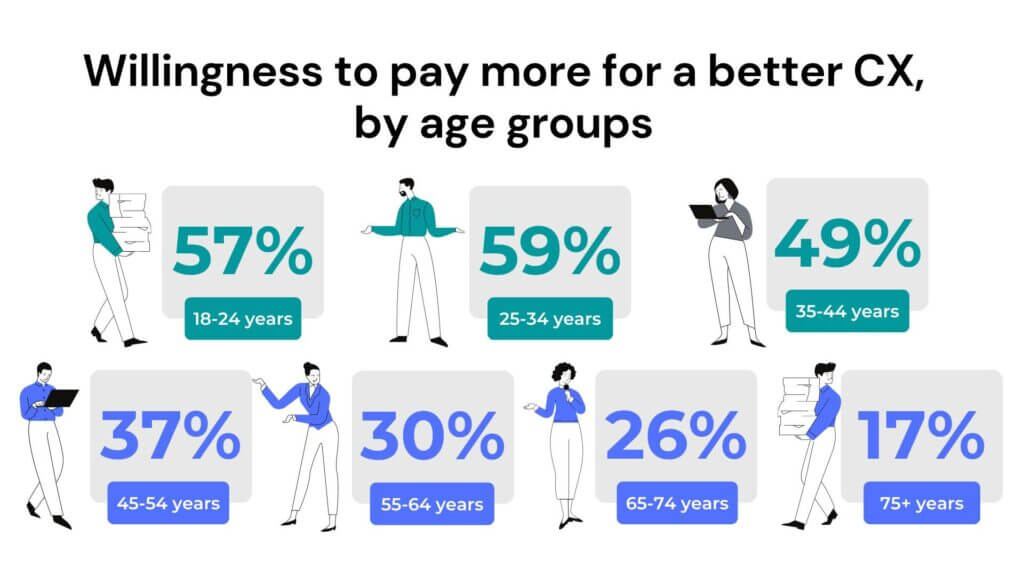Top 10 Customer Experience Tools Shaping 2024
Staying ahead in the ever-evolving realm of customer experience means embracing innovative tools and technologies that enhance interactions, foster loyalty, and drive business growth. In this article, we’ll go through the top 10 customer experience tools that are revolutionizing the way companies connect with their audience today.

1. AI-Powered Chatbots
AI-powered chatbots continue to be a game-changer in CX and are a must-have among the 10 customer experience tools by providing instant support and personalized assistance around the clock. These intelligent bots leverage natural language processing (NLP) and machine learning algorithms to understand customer queries and deliver relevant responses, significantly improving response times and customer satisfaction.
2. Voice Analytics Platforms
With the rising popularity of voice interactions, voice analytics platforms have become indispensable for companies looking to gain actionable insights from customer conversations. As one of the 10 customer experience tools, these platforms analyze voice data to uncover trends, sentiment, and customer preferences, enabling businesses to optimize their CX strategies and drive better outcomes.
3. Customer Journey Mapping Software
Customer journey mapping software allows businesses to visualize and understand every step of the customer journey, from initial engagement to post-purchase support. By identifying pain points and opportunities for improvement, companies can design more seamless and engaging experiences that resonate with their target audience.
4. Omnichannel Experience Platforms
Omnichannel experience platforms empower businesses to deliver consistent and cohesive experiences across multiple channels, including web, mobile, social media, and brick-and-mortar stores. As one of the 10 customer experience tools, these platforms synchronize customer interactions and data across channels, companies can provide a unified experience that enhances engagement and builds brand loyalty.
5. Personalization Engines
Personalization engines leverage data analytics and machine learning to deliver tailored experiences to individual customers based on their preferences, behavior, and past interactions. As one of the 10 customer experience tools, these engines serve relevant content, product recommendations, and promotions, enabling businesses to create meaningful connections with their audience and drive conversions.

6. Social Media Listening Tools
Social media listening tools enable companies to monitor and analyze conversations happening on social media platforms in real-time. By tracking mentions, sentiment, and trends, businesses can proactively engage with customers, address concerns, and capitalize on opportunities to enhance their brand reputation and CX.
7. Feedback and Survey Platforms
Feedback and survey platforms play a crucial role in gathering insights directly from customers about their experiences with a brand. By collecting feedback at various touchpoints, companies can identify areas for improvement, measure customer satisfaction, and prioritize initiatives that drive positive outcomes.
8. Predictive Analytics Solutions
Predictive analytics solutions leverage historical data and advanced algorithms to forecast future customer behavior and trends. By anticipating customer needs and preferences, businesses can proactively tailor their offerings and marketing strategies, driving higher engagement and loyalty.
9. Voice of Customer (VoC) Analytics Tools
Voice of Customer (VoC) analytics tools aggregate and analyze customer feedback from multiple sources, including surveys, reviews, and social media. By extracting actionable insights from unstructured data, companies can gain a deeper understanding of customer sentiment, preferences, and pain points, guiding strategic decision-making.
10. Augmented Reality (AR) and Virtual Reality (VR) Experiences
Augmented reality (AR) and virtual reality (VR) experiences are transforming CX by offering immersive and interactive experiences to customers. Whether it’s virtual product demos, AR try-on experiences, or immersive brand storytelling, these technologies create memorable moments that drive engagement and differentiate brands in crowded markets.

But what about the people?
Amidst the technological advancements and digital transformations, it’s crucial not to overlook the human element of CX. While tools and technologies can streamline processes and optimize interactions, it’s the people behind them who ultimately shape the customer experience. Empowering employees with the right training, resources, and support is essential for delivering authentic, empathetic, and memorable experiences that resonate with customers on a deeper level.

STRATEGY GUIDE
6 Simple Strategies To Improve Customer Retention
Actionable insights and proven techniques to keep your customers coming back.

At the end of the day
In conclusion, the landscape of customer experience is constantly evolving, and staying competitive requires leveraging the latest tools and technologies to delight and engage customers. As we’ve explored the top 10 customer experience tools shaping 2024, it’s clear that these innovations are revolutionizing the way companies connect with their audience. By embracing these top 10 customer experience tools in 2024, businesses can elevate their CX strategies, foster stronger connections with their audience, and drive sustainable growth in the digital age.
However, amidst the excitement of technological advancements, it’s essential not to lose sight of the human element of CX. Behind every tool and technology are the people who ultimately shape the customer experience. Empowering employees with the right training, resources, and support is fundamental for delivering authentic, empathetic, and memorable experiences that resonate with customers on a deeper level.
As we move forward into the future of CX, let’s remember that success lies not only in embracing innovative tools but also in cultivating a customer-centric culture where people are at the heart of every interaction. FrontLogix stands at the forefront of this by offering comprehensive tools and strategies that prioritize both technology and human connection. By seamlessly integrating cutting-edge technology with a deep understanding of human behavior and emotions, FrontLogix empowers businesses to forge genuine connections with their customers and drive sustainable growth in the competitive landscape of 2024 and beyond.

Found this useful?
Subscribe to our newsletter and get CX and WFM news delivered to your inbox.
Don’t worry, we won’t flood your inbox – just one insightful email a month!




























